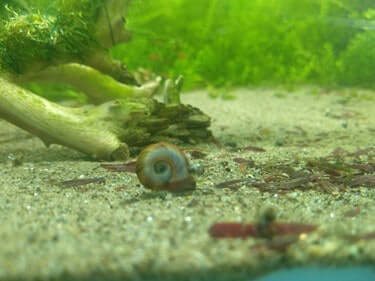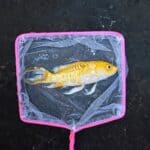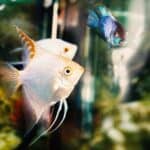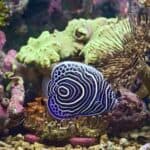Aquarium snails, or pest snails as they’re also known, seem to appear out of nowhere. They rapidly multiply, causing a nuisance and making them difficult to remove. However, some aquarium snails are significantly more beneficial than others.
Good snails clean the tank by eating decomposing matter, such as uneaten food, dying plants, and dead fish. This prevents ammonia levels from rising too high and keeps the algae population under control. However, pest snails rapidly multiply, overpopulating the tank. They do this by growing quickly and reproducing young.
Some snails are even asexual, while others are hermaphrodites, meaning both males and females have sexual reproductive organs. Once you have aquarium snails, they’re difficult to remove.
What Are Aquarium Pest Snails?
As their name suggests, aquarium pest snails are tiny snails that live underwater in fish tanks. The most common type of pest snails include:
- Malaysian trumpet snail
- Bladder snail
- Pond snail
- Apple snail
These are considered unwanted aquarium pests. However, there is also a range of other aquarium snails that can be beneficial to your tank. They’re not to be confused with the kind seen as pests. These are:
- Ramshorn snail
- Mystery snail
- Assassin snail
- Nerite snail
- Rabbit snail
While some snails can be helpful, most are considered pests because, as detritivores, they consume nutrients by feeding off detritus (decomposing matter). This includes decaying plants, fish feces, uneaten food, algae, and dead fish.
Because a standard fish tank contains an abundance of these foods, pest snails breed and multiply quickly, overwhelming the tank and affecting the water conditions.
They also seemingly appear out of thin air, causing many owners to question where they come from. They get into the tank in the following ways:
- By hitchhiking on aquarium plants that get added to the tank.
- By clutching onto driftwood before it gets put into the aquarium.
- Through the feces of other fish.
- Through gravel. Malaysian trumpet snails are known to live in gravel buckets for over a year.
Once you spot a snail, you’ll need to act quickly to remove it before your entire tank becomes overrun with the pests.
Are Aquarium Snails Dangerous?
Most aquarium pest snails are harmless and don’t present a deadly threat themselves. The biggest issue is that they multiply, taking over the entire aquarium.
While they don’t have an immediate effect on the tank, they’ll eventually make conditions dirty, reducing your aquarium fish’s quality of life. Aquarium snails can affect your tank in the following ways:
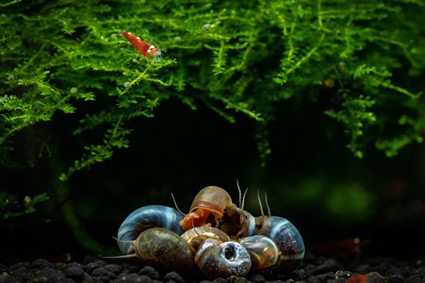
Rapidly Reproduce
As mentioned, aquarium pest snails rapidly reproduce and quickly become a problem inside the fish tanks they live inside.
One of the reasons they multiply so fast is because snails grow quickly and are able to reproduce when they’re only 35 days old. Many snails lay dozens of eggs at a time in one large sac, which causes the population to grow significantly at any one time.
Similarly, pest snails lay their eggs on the underside of plants, making them hard to spot and remove. They’re also transparent. Unless you’re specifically looking out for them, you’re unlikely to spot snail eggs.
Not only that, but some aquarium pest snails are hermaphrodites, so both males and females have sexual reproduction organs. This includes bladder and Malaysian trumpet snails. This means that hermaphroditic snails can reproduce regardless of their sex. Similarly, bladder snails are asexual, meaning they don’t even need another snail to reproduce.
As a result, it’s easy to see how your tank could be overrun in only a matter of weeks.
Increase Ammonia Levels
When there are too many aquarium pest snails in the tank, they create tons of waste that break down into ammonia and nitrites. That’s because their feces are nitrogenous.
In a standard tank with good water conditions, fish poo provides nutrients that keep the tank’s ecosystem well maintained. However, when snails overrun the tank, too much waste matter is present in the tank, meaning the beneficial bacteria and filtration system can’t cope with the added waste and can’t remove ammonia quickly enough.
In high quantities, ammonia is toxic to fish. Fish with ammonia poisoning will display the following signs:
- Red or cloudy eyes
- Gasping at the water’s surface
- Lethargy
- Loss of appetite
- Redness around gills
- Death
Whenever you discover pest snails in your tank, measure the ammonia levels to ensure they haven’t risen to unsafe levels. Then, deal with the pest problem.
Clog The Filtration System
Aquarium pest snails are drawn to the tank’s filters because they contain a generous build-up of bacteria, algae, and other decomposing matter that they can feed off. When you have an infestation, the filters are where you’re most likely to find the biggest congregation of pest snails.
However, when too many snails get into the filter, they clog it up and stop it from working properly. Clearing the filter should get it to work again, but the problem will keep reoccurring unless you deal with the pest situation.
If the filter isn’t fixed, toxins will build up within the tank and poison the fish.
What Are Aquarium Snails Good For?
Aquarium snails have a bad reputation, but they can actually be useful for your fish tank. However, this is only if you can keep the population under control to a manageable level. Snails can be helpful for the following reasons:
Keep Ammonia Levels Stable
While an unmanageable snail overpopulation can cause ammonia levels to rise, a few snails in the tank can also keep the levels stable, preventing harmful chemicals from increasing and making your fish sick.
As described by the Global Agriculture Alliance, decomposing matter creates an oxygen demand, releasing ammonia into the water. However, because aquarium snails feed off this matter, they can actually prevent this process from happening, keeping ammonia levels stable and your fish healthy.
Remove Decomposing Matter
Aquarium snails can be beneficial for removing decomposing matter from the tank. As explained, this includes uneaten, rotting food, dead fish, and dying plants. This keeps the tank’s conditions clean and healthy for longer.
The Malaysian trumpet snail is one such species. It burrows into the substrate looking for uneaten food, keeping the gravel clean as a result. This behavior also prevents the substate from compacting and becoming anaerobic.
The biggest problem with the Malaysian trumpet snail is that it overpopulates the tank, undoing its good work. That being said, some of the beneficial snail species we’ve already mentioned don’t breed as rapidly and can benefit the tank’s conditions.
While you should still carry out your bi-weekly water change, snails can prevent your fish from living in unsanitary conditions while they wait for clean water.
Reduce Algae Growth
Aquarium snails feed off algae, keeping the population under control. Algae rapidly multiply and are considered unsightly, so snails are an excellent natural solution to the problem. Not only that, but they delicately eat the algae off live plants, leaving them relatively untouched.
Nerite snails are the best algae eaters. They can get into small nooks and crannies, eating algae that you haven’t even seen. They’re also known to eat all kinds of algae and can help clean all areas of the tank.
Similar to decomposing matter, algae can be dangerous in high quantities. According to the Victoria State Government, some kinds of algae produce harmful toxins, creating an algae bloom. This can impact your fish’s health. As a result, adding snails to your aquarium could help prevent this.
Are Aquarian Snails Harmful To Fish?
Thankfully, aquarium snails don’t directly harm fish. They spend most of their time avoiding them, burying into the substrate, and tucking themselves into nooks and crannies where they’re protected from danger.
The issues come when snails start to affect the water’s quality by multiplying too quickly. Similarly, when the tank’s too cramped, fish are likely to become aggressive because they don’t have enough space to swim and move about in. Aquarium snails also live on and amongst plants, which is a fish’s primary source of shelter.
As a result, not all snails and fish live in harmony, so you must monitor your fish’s mood and behavior for any changes that signify they’re stressed or unhappy with their conditions. In many cases, aquarium snails are in danger of being eaten by many fish species. In particular, tiny snails make a tasty snack.
How To Prevent Aquarium Pest Snails
Removing aquarium snails is hard work. Even if you think you’ve got rid of them all, it only takes a couple of rogue snails to repopulate the tank. As a result, aim to prevent them from entering the tank in the first place to make life easier. To do so:
- Soak new decorations and accessories in bleach water before you add them to your tank. Alternatively, scrub them thoroughly to remove any eggs.
- Soak live plants using 2 to 3 teaspoons of Alum powder per gallon of water.
- If you don’t have access to Alum powder, quarantine them for 15 days in a separate tank before introducing them into your main aquarium.
- Inspect and clean all gravel before placing it in your aquarium. If in doubt, don’t put it in.
By following these steps, you should hopefully prevent pest snails from getting into your tank altogether.
How To Get Rid Of Snails In A Fish Tank?
While some aquarium tanks are beneficial, you may need to control the population or remove pest snails altogether. Unfortunately, if baby snails have appeared in your fish tank, you have an aquarium snail infestation that must be dealt with quickly and thoroughly.
However, bear in mind that if you use a solution to kill aquarium pest snails while they’re in the tank, you’re at risk of rising ammonia levels. As a result, you should aim to remove them from the tank first to protect your fish.
Similarly, snail-killing products are available, but there’s too much risk with the chemicals killing plants, invertebrates, and other life within the tank. Also, if snails die simultaneously, the tank’s ammonia levels will rise too quickly.
To learn how to dispose of aquarium snails, follow one of these methods:
Clean Plants And Accessories
As mentioned, snails like to live amongst plants, decorative features, and accessories. As a result, cleaning them and removing the snails each time you do a cycle change will help reduce the population.
To clean your plants, use a toothbrush or algae pad and gently scrub the surface, remembering to get into all the nooks and crannies. Rinse them off in clean water before adding them back into your tank.
You don’t necessarily need to use a solution to clean the plants. A thorough scrub should be enough.
Carry Out Regular Water Changes
Cleaning your aquarium with a bi-weekly water change is the best way to ensure your tank remains healthy. Over time, fish waste, rotting plant matter, and decaying food build-up, creating a bad environment for your fish to live in, but conditions that snails thrive in.
When cleaning your tank, focus on removing decaying matter that snails feed off. This will limit the food supply. The cleaning process will also naturally remove some snails.
Limit The Food Supply
You can reduce the number of pest snails in your tank by limiting their food supply. To do this, attempt the following things:
- Vacuum the gravel every time you do a water change to remove any rotten food or plants.
- Trim all dead bits off your plants.
- Remove as many algae as you can see from the tank, scrubbing them off the plants and glass sides.
- Be careful not to overfeed your fish to prevent rotting food in the tank.
While cutting the snail’s food supply won’t get rid of all the snails, it’ll be enough to restrict the population to a more manageable size. That way, you can either keep control of the snails in your tank or remove the remainder using a different method.
Introduce A Snail-Eating Snail
Assassin snails are carnivorous and will eat other snails. They won’t eat their own kind, but they can help keep your pest snail population under control when you have other species living in your tank.
Unlike other pest snails, they’re gonochoristic, which means there are clear distinctions between the sexes, and only the females have reproductive organs. As a result, to get your snail population under control and ensure your assassin snails don’t breed, add a few of the same sex into your aquarium.
You could even let the snails live out the rest of their days in the tank, allowing them to keep the conditions healthy and clean. However, make sure you don’t have snail-eating fish in the aquarium before you commit to this method of removal.
Manual Removal
If you’re feeling brave, you could try removing as many of the snails as you can by hand. Getting rid of the larger adult snails means you’re more likely to remove the breeding snails that are responsible for overpopulating the tank.
This is a suitable method if you don’t have many snails in the tank or need to reduce the population. However, always wear gloves whenever handling snails to minimize the risk of touching and spreading harmful bacteria.
Similarly, it’s not safe for either you or fish to put a bare hand into the water, as you could both transfer and contract harmful bacteria.
Trap The Snails
You can trap lots of snails at once with an easy homemade trapping method. To make your own, follow these steps:
Equipment:
- 20 oz plastic water bottle
- Scissors
- Boiled or steamed vegetables, such as broccoli or carrots
- A small handful of gravel
Method:
- Use the scissors to cut a third of the bottle off the top.
- Put the vegetables inside the bottle.
- Put the gravel on top to weigh everything down.
- Invert the top of the bottle into the bottom. This should create a funnel that stays in place.
- Place the trap in the aquarium straight up. Don’t let it fall over, as it won’t work.
- When morning comes, you should see lots of snails in the bottle. Scoop out the bottle and safely discard the snails.
You can also buy snail traps online if you’re looking for a more ready-made solution.
Are There Any Fish That Eat Snails?
There are plenty of snail-eating fish that you can add to your tank to control the snail population. However, make sure you choose a fish that fits in with your current community. The following fish should sort out a snail problem:
Betta Fish
Betta fish will eat anything in the tank given the chance. That’s because they’re opportunistic eaters. As a result, they’ll consume small pest snails.
However, bettas are temperamental, and their personalities differ from fish to fish, so it’ll take some trial and error to see if they go for the snails. Some might turn their noses up at the snails on offer.
Cory Catfish
Cories are unlikely to eat live snails, but they’ll eat the eggs. This could work in your favor, as the live fish will keep the tank clean by eating decomposing matter, and your cories will keep the population under control, preventing the pest snails from reproducing.
Cory catfish are also great maintenance fish and make an excellent addition to most community tanks.
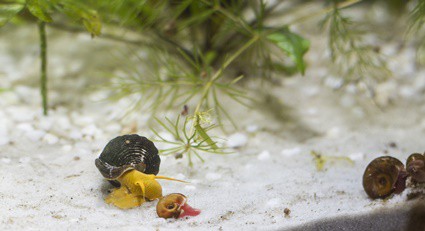
Goldfish
Large goldfish are more than happy to eat pest snails. In fact, they won’t stop until they’ve consumed the whole lot.
However, goldfish aren’t a tropical species, so you can’t add them to a warm water tank. If you have a cold water tank that’s suffering from a pest snail problem, consider adding at least one goldfish.
Green-Spotted Pufferfish
Green-spotted pufferfish are renowned for eating snails. They have bony plates in their mouths that continuously grow. As a result, they eat hard foods to grind them down. Snails are the perfect creatures to help them do this because of their hard shells. Pond snails are also a natural food source for wild pufferfish.
The downside is that they’re not great community fish and will eat most other creatures in the tank alongside the snails. What you could do is house your community fish in a temporary tank while you let the puffer fish clear out the pest snails.
Loach Fish
Both clown and yoyo loaches are excellent snail-eaters and will eat any they can find. However, they both grow to be incredibly large. Clownfish also need to live in schools of six, so they rarely make a good option for standard community tanks.
Yoyo loaches grow half the clown’s size, so they’re a much better option for most owners. They also have a large appetite for snails.
Before deciding what to do with your snails, do some research to find out whether they’re likely to be pests or beneficial to your tank. In some cases, you might find it’s better to keep at least some in your aquarium to keep the conditions under control.

